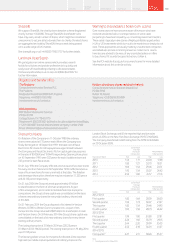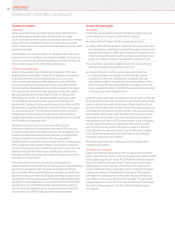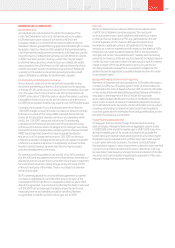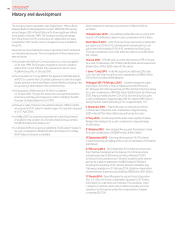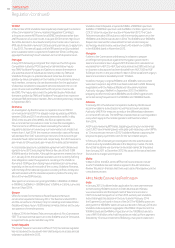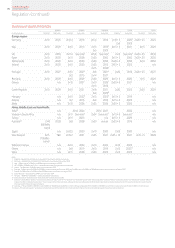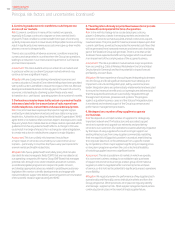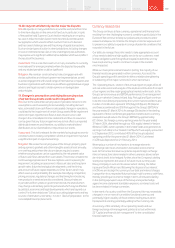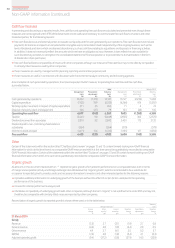Vodafone 2014 Annual Report Download - page 195
Download and view the complete annual report
Please find page 195 of the 2014 Vodafone annual report below. You can navigate through the pages in the report by either clicking on the pages listed below, or by using the keyword search tool below to find specific information within the annual report.
As a mandatory condition of acquiring the 900MHz spectrum in Delhi,
Mumbai and Kolkata, Vodafone India has applied for the new Unied
Licence and is negotiating the agreement of specic terms prior
to the commencement of the new spectrum in November 2014.
Further spectrum licences expire in December 2016 and new licences
are expected to be auctioned later in the current nancial year.
For information on litigation in India, see note 30 “Contingent liabilities”.
Vodacom: South Africa
The Ministry of Trade and Industry (‘DTI’) published revised generic
Codes of Good Practice on Broad-based Black Economic Empowerment
(‘BEE’) during October 2013, following an intensive consultation process.
These revised codes will come into effect in April 2015. In addition,
the Broad-based Black Economic Empowerment Amendment Act No.
46 of 2013 was promulgated in January 2014. This Act will come into
force on a date still to be proclaimed by the President. A provision for
BEE legislation to take precedence over sectoral legislation contained
in the Act will only be effective 12 months after the proclamation date.
In October 2013, Cell C lodged a complaint with the Competition
Commission of South Africa (‘CompCom’) against Vodacom (and
MTN), in relation to alleged discriminatory pricing of on-net and off-net
calls. Vodacom submitted its response in January 2014 however
CompCom has decided to proceed with the formal investigation of Cell
C’s complaint.
In December 2013, the Ministry of Communications published the nal
National Broadband Policy which sets out the Government’s national
broadband policy objective of 100% broadband penetration by 2030.
Amongst the measures being considered to achieve this objective is the
establishment of a single national wholesale network. The Ministry
of Communications has appointed a National Broadband Council
(comprising of experts in the eld) to advise on the implementation
of the National Broadband Policy, including the desirability and business
case of a single national wholesale network.
In January 2014, the Ministry of Communications commenced the
consultation process on the National Integrated ICT Policy Green Paper
(the ‘Green Paper’) to, amongst other things, dene the allocation
of 4G spectrum, the rural broadband coverage plans and the future
organisational structure of the national regulatory authority (the ‘NRA’).
After the consultation process on the Green Paper, the paper will mutate
into a National Integrated Information Communications Technology
Policy White Paper (the ‘White Paper’). The tentative timeline for the
publication of the White Paper is August 2014.
In February 2014, the NRA published Call Termination Regulations
(‘CTR’) determining the cost of terminating a call on a Mobile Network
Operator (‘MNO’) to be ZAR 0.10. The target rate of ZAR 0.10, so the
NRA decreed, would be reached over three years after a decline
to ZAR 0.20 in year one followed by another decline to ZAR 0.15 in year
two. Asymmetrical rates, as an additional regulatory remedy ranging
between 120% and 300%, were also imposed in the same CTRs for
the benet of Cell C and Telkom Mobile (the ‘two smallest MNOs’).
Vodacom and MTN (the ‘two largest mobile MNOs’) challenged the
validity and legality of the NRA 2014 CTRs in the Johannesburg High
Court, South Africa (the ‘High Court’) on the grounds that in setting the
new MTRs, the NRA had acted arbitrarily and irrationally without any
regard to the requirements of the Promotion of Administrative Justice
Act (‘PAJA’) and the Electronic Communications Act (the ‘ECA’).
On 31 March 2014, the High Court upheld Vodacom and MTN’s
challenge and ruled that the NRA 2014 CTRs were invalid and unlawful.
However, the High Court invoked its judicial discretion to suspend this
order – in the public interest – for a period of six months. During this
period, MTRs will decline from ZAR 0.40 to ZAR 0.20. Vodacom and
MTN will pay an asymmetrical rate of ZAR 0.44 for their calls terminating
on Cell C and Telkom Mobile’s networks. ICASA is required during this
window period of six months to develop legally tenable CTRs.
Turkey
From January 2014, the price cap for national SMS was reduced by 20%
from 41.54 Kr to 33.25 Kr. In addition, the requirement for the on net
price to be higher than 1.7 times MTR has been extended to tariff
campaigns for operators who have signicant market power.
In February 2014, the new Basket Law amending Law No. 5651
(Internet Cyber Crimes) provides that an Access Providers Union shall
be established to require telecommunications operators to monitor and
intercept internet services, where required by the law.
Australia
In September 2013, a range of xed services reviews were initiated
by the Australian Communications and Media Authority (‘ACMA’)
including for unbundled local loop and regional transmission services.
In addition, the change of Government has resulted in a range
of reviews to reduce the cost of the roll-out of the National Broadband
Network. This will reduce the amount of bre to the premises (‘FTTP’)
to be deployed and increase more bre to the node (‘FTTN’) technology.
Egypt
In October 2013, the Administrative Court issued a ruling in the lawsuit
for the case led by Vodafone Egypt against Telecom Egypt and the
national regulator (‘NTRA’) regarding the authority to set MTRs between
mobile and xed operators and we expect to receive the formal Court
ruling later this year.
In April 2014, the Minister of Communications and Information
Technology announced the proposed framework of the unied
telecoms licence, with the expectation that all matters would
be nalised in June 2014. The Minister’s proposal, which is subject
to negotiation, provides the opportunity for Telecom Egypt to purchase
their own mobile licence whilst providing Vodafone Egypt with
a number of options on purchasing virtual local loop unbundling
(‘VLLU’), part ownership of an infrastructure licence and its own
international gateway licence. A requirement of the current proposal
is for Telecom Egypt to sell its 45% share in Vodafone Egypt within
12 months of 30 June 2014.
New Zealand
In January 2014 , Vodafone New Zealand secured 2x15MHz of 700MHz
spectrum for the reserve price of NZ$66 million. A second phase of the
auction to determine the allocation of specic sub-bands to licensees
is ongoing.
Safaricom: Kenya
Safaricom Limited is in the process of renewing its operating licence for
ten years with effect from 1 July 2014. The renewed licence will include
Safaricom Limited’s spectrum resources in 900MHz and 1800MHz.
Safaricom also holds spectrum resources in the 2.1GHz band, under its
3G licence.
Qatar
In December 2013, the Ministry of Information and Communications
Technology (‘MICT’) released a national broadband plan to guide
policy on the development of broadband. One objective of the plan,
is for 98% of households to have access to 100 Mbps download
and 50 Mbps upload speeds and a choice of at least two service
providers. This includes an intention to consolidate the access network
infrastructure of the incumbent Ooredoo and the Qatar National
Broadband Network, both of which are deploying FTTP networks.
An Emiri Decree was issued in February 2014, establishing the MICT
and the national regulator, the Communications Regulatory Authority
(‘CRA’), as separate bodies. Formerly, the two entities were part of the
secretariat of the Supreme Council of Information and Communication
Technology (‘ictQATAR’).
During 2014, the Communications Regulatory Authority intends
to grant Vodafone Qatar additional spectrum of 2x5MHz in the
1800MHz band and 2x10MHz in the 800MHz band, to support 4G
deployment subject to speed and coverage obligations.
193Overview Strategy
review Performance Governance Financials Additional
information


